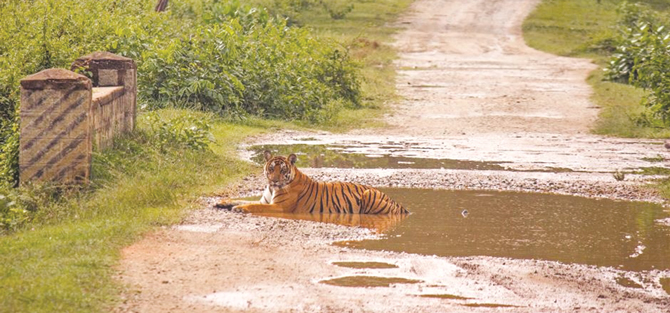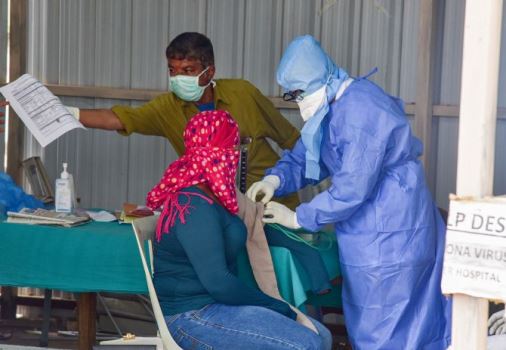Bardiya tiger looks fine with new life in Central Zoo

By Indira Aryal
Kathmandu, Apr. 22: How does a tiger brought from the wild feel inside a cage? It must feel like a lonely prisoner in a zoo, having lost all the freedom it used to enjoy in the jungle.
A man-eater tiger recently brought from Bardiya National Park (BNP), however, looks quite contented with life in a cage, inside the Central Zoo in Jawalakhel, Lalitpur.
The Royal Bengal tiger, which used to roam freely in the dense forest of Bardiya park, is now gradually adapting to the life in confinement. It eats fresh meat and behaves normally, said the chief of National Trust for Nature Conservation Central Zoo, Dr. Chiranjivi Prasad Pokharel.
Recently named “Bardiya Baagh” by the zoo officials, the large wild cat was darted and brought there from the BNP on April 7, after it killed Policeram Tharu.
Tharu, 31, a mahout involved in the rhino count at Gaidamachan, inside the park was killed by the tiger.
The wild cat is also believed to have killed another person: a woman named Dalli Rawat, 55, of the Thakurbaba Municipality in the district on March 16, 2021.
The tiger attacked Rawat when she and three other women were collecting firewood in the park.
“The man-eater has started eating ready-made meat and has been behaving well. We are amazed at seeing the tiger adjusting to the new environment within a few days,” Dr Pokharel said.
Currently, the zoo has five tigers, including the new comer from Bardiya. Four others were brought from Chitwan National Park (CNP) after they behaved violently. “Mostly, we bring the violent and sick wild animal to the zoo to treat them, as well as tame them. If they start behaving normally, we will release them to the wild,” he said.
All the tigers have been given names. A female tiger of around five years of age brought from the CNP is named “Jagati”, and male tigers of around 16 years, 11 years and four years of age brought from the same park are called Maharaj, Bange and Pratap respectively.
According to Dr. Pokhrel, the tiger was fed three kilograms of meat and water on the day after its arrival. The next day, after a health check-up, some medicine alongside the meat were given. And from now on, every Saturday, it will have a fasting day.
Normally an adult healthy tiger can eat up to 40 kilograms of meat at a time and they could go hungry for many days in the wildlife until they find a prey. But here in the captive life, they get regular food twice a day, he said.
Dr. Pokharel said that the tiger’s paw got injured while transporting it from Bardiya and that the wound had been healing since treatment began.
“It has been kept away from other animals in a bid to inhibit it from attacking them, and it seems to be enjoying loneliness,” he said.
So far, 10 people have died from tiger attacks in Bardia in the past nine months.
According to the 2018 census, there were 87 tigers in the dense forest of Bardiya. That number is estimated to have gone up in recent times. Another tiger census will be conducted in November this year.
Recent News

Do not make expressions casting dout on election: EC
14 Apr, 2022
CM Bhatta says may New Year 2079 BS inspire positive thinking
14 Apr, 2022
Three new cases, 44 recoveries in 24 hours
14 Apr, 2022
689 climbers of 84 teams so far acquire permits for climbing various peaks this spring season
14 Apr, 2022
How the rising cost of living crisis is impacting Nepal
14 Apr, 2022
US military confirms an interstellar meteor collided with Earth
14 Apr, 2022
Valneva Covid vaccine approved for use in UK
14 Apr, 2022
Chair Prachanda highlights need of unity among Maoist, Communist forces
14 Apr, 2022
Ranbir Kapoor and Alia Bhatt: Bollywood toasts star couple on wedding
14 Apr, 2022
President Bhandari confers decorations (Photo Feature)
14 Apr, 2022









